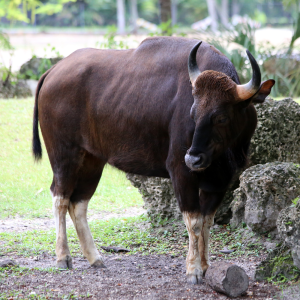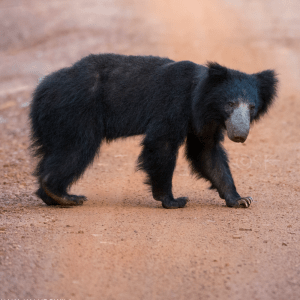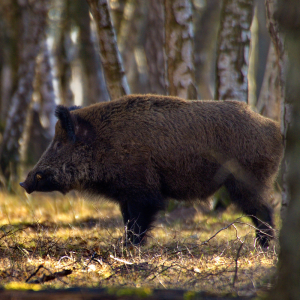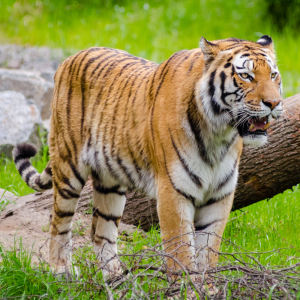PHYSIOLOGY | IMAGES | ETYMOLOGY | TAXONOMY | GEOGRAPHY | BEHAVIOR | DIET | REPRODUCTION | ECOLOGY | CONSERVATION | FAUNAFACTS | VIDEO | SOURCES

The tiger is the largest member of the Felidae family, categorized within the Carnivora order under the higher Mammalia class. They are most recognizable for their dark vertical stripes which help in camouflage efforts as they stalk their prey within thick vegetation. Listed as “Endangered” with a population of mature individuals at fewer than 2,500 individuals, tigers often face conflict with humans.
Physiology
The tiger is the largest and most powerful of all living cat species. Variation in the body sizes of tigers and other morphological characteristics follows a gradient, rather than being discrete to subspecies. Although different subspecies of tiger have different characteristics, in general, male tigers weigh between 200 and 260 kilograms, (400-715 pounds.) Adult females are slightly smaller and lighter, weighing 100-160 kilograms, (220-400 pounds.) The males are between 5 feet 10 inches to 9 feet 1 inch in length, and the females are between 7 feet 6 inches and 9 feet in length.
Like other cats, tigers are digitigrade, that is, they walk on their toes. The soft toe pads distribute the weight over the balls of the feet, giving tigers not only a fluid walking motion, but also a silent one.
The tiger has a coat pattern of black stripes against a dark gold background. The pattern of stripes is unique to each tiger and can be used to identify individuals, much in the same way as fingerprints are used to identify people. This is not, however, a preferred method of identification, due to the difficulty of recording the stripe pattern of a wild tiger. The stripes of most tigers vary from brown or hay to pure black. The stripe pattern is found on a tiger’s skin, as well as on the fur. If you were to shave a tiger, you would find that its distinctive camouflage pattern would be preserved. The form and density of stripes differs between subspecies, but most tigers have in excess of 100 stripes.
An analysis of sexual dimorphism in the skull of tigers found that the greatest divergence occurred in the area involving the predatory function, specifically around the muzzle; as well as with the width of the zygomatic arches, (bones on the side of the skull below the orbits;) the size of the sagittal crest, (crest on top of the skull;) and the lambdoidal crest, (at the back of the skull.) These characteristics are more robust in males, suggesting that males may take larger prey than females.
Tigers have the longest and biggest canine teeth of all the wild cats. A tiger’s canines are larger and longer than those of a similar-sized lion (Panthera leo).

SEXUAL DIMORPHISM
Males with Larger HeadsSHOULDER HEIGHT
71-122 cm. / 28-48 in.BODY LENGTH
1.47-3.38 m. / 4.8-11.1 ft.BODY MASS
74-325 kg. / 165-716 lb.DENTAL FORMULA
I ³⁄1, C ³⁄1, P ³⁄1, M ²⁄1, ×2 = 30LIFESPAN
14-18 yr.GENERATION LENGTH
6.5-10 yr.LOCOMOTION
Digitigrade

Images
Taxonomy
Nine subspecies of the tiger are recognized. Three, P.t. sondaica, (Javan); P.t. balica, (Bali); and P.t. virgata, (Caspian), became extinct in the mid- to late-twentieth century. P.t. amoyensis, (South Chinese), exists only in captivity. Four, P.t. altaica, (Amur); P.t. corbetti, (Indochinese); P.t. sumatrae, (Sumatran); and P.t. tigris, (Bengal), survive in a much reduced and fragmented range relative to one century ago. A final peninsular subspecies, P.t. jacksoni, (Malayan), was named for the renowned tiger conservationist, Peter Jackson.
Traditionally, these subspecies were defined by their geographic distribution combined with morphological traits such as body size, skull traits, coat color, and striping patterns. Later, several lines of evidence suggested that the classical subspecies designations were not reliable.
Of the living tiger subspecies, Sumatran tigers are the smallest, and Bengal tigers are the largest. Surprisingly, while Siberian or Amur tigers have long been thought to be the largest of the subspecies, measurements of tigers from the Russian Far East show they are currently no larger than the Bengal tigers of the Indian subcontinent. An average Bengal tiger is about 3 meters from the tip of the nose to the end of the tail. Females are usually 8-8.5 feet, while males can grow to slightly over 10 feet. The average weight of Bengal females is 220-350 pounds, while males weigh about twice as much at 420-750 pounds. Tigers from Sumatra and other Indonesian islands are smaller and darker with shorter hair than tigers from more northern areas. Adult males in tropical areas average 2.2 to 2.5 meters in total length (nose to tip of tail,) which is about a half meter shorter than males from northern areas, and weigh only 100 to 140 kilograms. Adult females in tropical areas weigh 75 to 110 kilograms, or roughly as much as a large leopard (Panthera pardus) or jaguar (Panthera onca). The smaller body size of tigers from southern latitudes is likely to be due to an adaptation to the higher temperatures where heat must be dissipated, as well as a way to reduce energy needs in an environment where large ungulate prey are not readily available. Tigers in northern latitudes are larger cats and often deal with seasonally high temperatures by spending most of the day-time hours lounging half-submerged in shaded pools or streams.
The form and density of a tiger’s stripes differs between subspecies, but most tigers have in excess of 100 stripes. The now extinct Javan tiger may have had far more.
Only Bengal tigers have been found with the white color coat. It has been determined that some individuals carry a recessive gene for a white coat color. White colored tigers are not albinos. White tigers have far fewer apparent stripes than orange tigers.
KINGDOM
AnimaliaPHYLUM
ChordataCLASS
MammaliaORDER
CarnivoraFAMILY
FelidaeGENUS
PantheraSPECIES
tigrisSUBSPECIES (9)
P. t. tigris (Bengal), P. t. altaica (Amur/Siberian), P. t. amoyensis (South Chinese), P. t. balica (Balinese), P. t. corbetti (Corbett’s/Indo-Chinese), P. t. jacksoni (Malayan), P. t. sondaica (Javan), P. t. sumatrae (Sumatran), P. t. virgata (Caspian/Culo/Hyrcanian/Turan)
Etymology
The generic name Panthera is derived from the Latin word panthera, and the Ancient Greek word πάνθηρ panther. The Sanskrit word पाण्डर pāṇḍ-ara means pale yellow, whitish, white.
The Middle English tigre and Old English tigras derive from Old French tigre, from Latin tigris. This was a borrowing of Classical Greek τίγρις tigris, a foreign borrowing of unknown origin meaning tiger and the river Tigris. The origin may have been the Persian word tigra meaning pointed or sharp, and the Avestan word tigrhi arrow, perhaps referring to the speed of the tiger’s leap, although these words are not known to have any meanings associated with tigers.
GROUP
Ambush, StreakFEMALE
TigressYOUNG
Cub, Whelp
Region
The tiger once ranged widely across Asia, from Turkey in the west to the eastern coast of Russia. Over the past 100 years, tigers have disappeared from southwest and central Asia, from two Indonesian islands, Java and Bali, and from large areas of Southeast and Eastern Asia. Tigers inhabit less than 6% of their historic range, with a 42% decline since 2006.
Breeding populations of tigers are currently found in eight range states: Bangladesh, Bhutan, India, Indonesia, Malaysia, Nepal, Russia, and Thailand. There is evidence of breeding in China and Myanmar between 2009 and 2014, though these populations are likely dependent on immigration from neighboring countries. Tigers may still persist in North Korea, although there has been no recent confirmed evidence.
The Indian subcontinent is home to more than 80% of the wild tigers in the world. Breeding populations of tigers are currently found in eight range states: Bangladesh, Bhutan, India, Indonesia, Malaysia, Nepal, Russia, and Thailand.
There is evidence of breeding in China and Myanmar between 2009 and 2014, though these populations are likely dependent on immigration from neighbouring countries. Tigers may still persist in North Korea, although there has been no recent confirmed evidence.
EXTANT
Bangladesh, Bhutan, China, India, Indonesia, Lao, Malaysia, Myanmar, Nepal, Russia, ThailandPOSSIBLY EXTINCT
Cambodia, China, Korea, VietnamEXTINCT
Afghanistan, China, Indonesia, Iran, Kazakhstan, Kyrgyzstan, Pakistan, Singapore, Tajikistan, Turkey, Turkmenistan, Uzbekistan
Habitat
Part of the tiger’s ability to persist in current and changing landscapes is its flexibility.
Tigers are tolerant of an unbelievably wide range of habitat conditions. They are at home in the hot, dry thorn forests of Rajasthan and the steamy tidal mangrove swamps of the Sundarbans. They can live in tropical forest, or pine, oak, and birch woodlands of the Russian Far East, surviving in temperatures of -34° Celsius.
That they can persist in such vastly different and diverse environments is an affirmation of a relatively low-energy-expenditure lifestyle that features fairly high success rates in capturing prey, short chases of prey, and long intervals between kills of large prey.
Tigers are carnivorous and need to kill 50-60 large prey animals per year. As such, availability of a sufficient prey base of large ungulates is the tiger’s major habitat requirement. Wild boar (Sus scrofa) and deer of various species are the two prey types that make up the bulk of the tiger’s diet, and, in general, tigers require a good population of these species in order to survive and reproduce.
FOREST
Boreal, Montane, Subtropical/Tropical Dry, Subtropical/Tropical Moist Lowland, Subtropical/Tropical Mangrove Vegetation Above High Tide Level, Subtropical/Tropical Moist MontaneSHRUBLAND
Subtropical/Tropical Dry, Subtropical/Tropical MoistGRASSLAND
Subtropical/Tropical Dry, Subtropical/Tropical Seasonally Wet/Flooded
Co-Habitants

Gaur 
Leopard 
Sloth Bear 
Wild Boar 
Rusty-Spotted Cat 
Dhole 
Common Palm Civet 
Grey Wolf
Behavior
While some hunting activity occurs in the daytime, tigers are mostly nocturnal, exhibiting a pattern of activity that coincides roughly with that of their principal prey.
A tiger’s time is largely consumed by the need to find food, and tigers typically travel widely to find enough to eat. Not surprisingly, there are few reliable estimates of the distances traveled in the course of a night’s hunting. In the Russian Far East, by following fresh tiger tracks in the snow, researchers estimated that tigers commonly traveled 15-20 kilometers per day. In Chitwan National Park, radio-tagged tigresses covered about 7-10 kilometers per night, traveling at roughly 0.7 kilometers per hour. Males traveled farther than females, and one adult male in Chitwan regularly used the park road to traverse the length of his territory, often walking 30 kilometers in a night. In Nagarahole National Park, where prey is super-abundant, radio-tagged tigers cover only about 3 kilometers per night, and move at a mean rate of 0.21 kilometers per hour. This is a remarkably short distance and, in addition to not traveling very far, Nagarhole tigers also spend only a few hours, (25-35% of the night,) on the move. In Chitwan, tigresses were active and moved intermittently throughout the night, suggesting that tigers in Nagarahole rely more on ambush than active searching to locate prey, a likely consequence of an abundance of ungulate prey in Nagarahole.
Tigers are generally solitary, with adults maintaining exclusive territories, or home ranges. They do not maintain strict territories, but their home ranges are often maintained unless threatened by other tigers. They follow specific trails within their ranges. Adult female home ranges seldom overlap, whereas male ranges typically overlap from 1–3 females, a common felid pattern of social organization. Males are intolerant of other males within their territory. Because of their aggressive nature, territorial disputes are violent and often end in the death of one of the males. To identify his territory, the male marks trees by spraying urine and anal gland secretions on trees as well as by marking trails with scat. Tiger home ranges are small where prey is abundant. Female home ranges in Chitwan averaged 20 km², while in the Russian Far East they are much larger at about 400 km². Similarly, reported tiger densities range from a maximum of 17-19 Tigers per 100 km² where prey are abundant, such as India’s Kaziranga and Corbett National Parks, to as low as 0.13–0.45 per 100 km² where prey is more thinly distributed, as in Russia’s Sikhote Alin Mountains.
It seems likely that the function of a tiger’s stripes is camouflage, serving to hide the animal from its prey. Most tigers live in forests or grasslands, for which their camouflage is ideally suited, and where it is easy to hunt prey that is faster or more agile. In the wild, even in semi-open habitats, the striped coat seems to break up the body outline, and the cat almost fades from view. Similarly, its dark, golden orange coat looks as if it would stand out like a beacon against a background of tropical green, but it blends into the forest patterns of sunlight and shadow, perfect camouflage for this large stalking predator. Few large animals have color vision as capable as that of humans, so the color is not as great of a problem as one might suppose. Tigers have red color vision.
Among the big cats, only the tiger and jaguar (Panthera onca) are strong swimmers. Tigers are often found bathing in ponds, lakes, and rivers. Tigers in northern latitudes are larger cats and often deal with seasonally high temperatures by spending most of the day-time hours lounging half-submerged in shaded pools or streams.
In the wild, tigers are one of the highest-jumping mammals, perhaps second only to the puma (Puma concolor).
CIRCADIAN RHYTHM
Nocturnal
Diet
Tigers are carnivorous and need to kill 50-60 large prey animals per year. As such, availability of a sufficient prey base of large ungulates is the tiger’s major habitat requirement. Wild boar (Sus scrofa) and deer of various species are the two prey types that make up the bulk of the tiger’s diet, and, in general, tigers require a good population of these species in order to survive and reproduce.
Tigers are opportunistic predators, however, and their diet includes birds, fish, rodents, insects, amphibians, and reptiles in addition to other mammals such as primates and porcupines like Malayan (Hystrix barchyura), Sumatran (Hystrix sumatrae), long-tailed (Trichys fasciculata) Indian crested (Hystrix indica), and Asiatic brush-tailed (Atherurus macrourus) porcupines.
Physically, tigers are powerful, burly animals, well equipped to single-handedly capture and subdue prey at least fives times their own weight. Tigers can take ungulate prey much larger than themselves, including large bovids, such as wild water buffalo (Bubalus arnee), gaur (Bos gaurus), and banteng (Bos javanicus), and even Asian elephants (Elephas maximus), greater one-horned rhinos (Rhinoceros unicornis), Sumatran rhinoceros (Dicerorhinus sumatrensis), leopards (Panthera pardus), and bears, such as sun bears (Helarctos malayanus), sloth bears (Melursus ursinus), and Asiatic black bears (Ursus thibetanus).
The tiger’s forelimbs, massive and heavily muscled, are used to hold tightly onto prey and to avoid being dislodged, especially by large prey such as gaur. A single tremendous blow of the paw can kill a full-grown grey wolf (Canis lupus).
However, like many large carnivores, preferred prey are key to successful reproduction and are those species that are approximately the same weight as tigers, themselves.
Of all the land carnivores, the tiger is the only species that has been known to charge and take down a full-grown male Asian elephant, one-on-one. However, due to the depletion of both species, these extraordinary confrontations become exceedingly rare and are hardly ever witnessed by humans in the wild.
The tiger’s skull is large and foreshortened, which increases the bite strength on a formidable set of canine teeth. Tigers have the longest and biggest canine teeth of all the wild cats. A tiger’s canines are larger and longer than those of a similar-sized lion (Panthera leo). The reason for this is likely due to the habit of preying on large herbivores in the tiger’s habitat whose bones are thick and large. The tiger’s canines have to be strong enough to break the bones of its prey. Moreover, as tigers hunt alone to bring down their prey, they have to work harder than lions, which hunt in groups.
Tigers are not runners and rarely pursue prey more than 150 meters, but rather, they rely on explosive acceleration. The tiger’s lithe body, flexible spine, and well-muscled hind limbs all combine to give it quickness, agility, and power. Tigers often ambush their prey as other cats do, (including the domestic cat (Felis catus,) overpowering their prey from any angle, using their body size and strength to knock prey off balance. A short, thick neck, broad shoulders, and massive forelimbs are ideal for grappling with prey while holding onto it with the long, retractive claws on the broad forepaws. Once prone, the tiger bites the back of the neck. For large prey, a bite to the throat is preferred. After biting, the tiger then uses its muscled forelimbs to hold onto the prey, bringing it to the ground. The tiger remains latched onto the neck until its prey dies.
Powerful swimmers, tigers are known to kill prey while swimming. Some tigers have even ambushed boats for the fishermen on board or their catch of fish.
The fact that tigers can persist in such vastly different and diverse environments is an affirmation of a relatively low-energy-expenditure lifestyle that features fairly high success rates in capturing prey, short chases of prey, and long intervals between kills of large prey.
PREFERENCE
GeneralistSTYLE
Ambush
Reproduction
Wandering male tigers may kill cubs to make females receptive.
Males show a behavior called flehmen, a grimacing face, when identifying the condition of a female’s reproductive condition by sniffing their urine markings. Females come into estrus every 3-9 weeks and are only receptive for 3-6 days. As such, mating is frequent during that time period. A pair will copulate frequently and noisily, like other cats.
A female tiger’s gestation period is 96-111 days and 1-7 cubs are born. On average, tigers experience a gestation period for 103 days and birth a litter of 2-3 cubs. In Siberian tigers the average litter size is 2.65 (n=123;) similar averages have been found in other tiger subspecies.
Newborn tiger cubs are blind and helpless, weighing from 780 to 1600 grams. The eyes do not open until 6-14 days after birth and the ears from 9-11 days after birth. The mother spends most of her time nursing the young during this vulnerable stage. Weaning occurs at 90-100 days old.
Tiger cubs are raised solely by their mothers until they embark for their own territories at around 2-2.5 years of age. Cubs start following their mothers out of the den at about 2 months old and begin to take some solid food at that time. From 5-6 months old, the cubs begin to take part in hunting expeditions and start learning to hunt and kill.
Cubs stay with their mother until they become independent at 18 months to 3 years old. It is not until they are around 2-2.5 years old that they leave their mother. Female tigers generally own territory near their mothers, while males tend to wander in search of territory, which they acquire by fighting and eliminating a territorial male.
Young tigers do not reach sexual maturity until around 3-4 years of age for females and 4-5 years of age for males.
BREEDING SEASON
November-AprilBREEDING INTERVAL
3-4 YearsESTROUS CYCLE
3-9 WeeksPARENTAL INVESTMENT
MaternalGESTATION
96-111 DaysLITTER
1-7EYE OPENING
6-14 DaysEAR OPENING
9-11 DaysWEANING
90-100 DaysINDEPENDENCE
2-3 YearsSEXUAL MATURITY
3-5 Years
Ecology
Dholes (Cuon alpinus) have been witnessed stealing kills from tigers and hounding, and harassing the big cat. There are even unconfirmed observations of dholes killing the panther. Because, no verified stories of dholes actually killing a tiger exist, though, such tales may be more legend than reality. Dholes have been documented to have been killed by tigers indicating that tigers may be behaviorally dominant over dholes.
Tigers breed well in captivity, and the captive population in the United States may rival the wild population of the world.
In China there are several operations engaged in intensive breeding or farming, of tigers, with the captive population reportedly reaching over 6,000. They are pressuring the government to allow them to produce tiger products, and several have already engaged in illegal production of tiger bone wine.
Humans are the tiger’s only serious predator. There are several illegal markets for tiger products, especially skins, but also teeth and claws, particularly in Sumatra, contributing to poaching pressure. Tiger bone has long been considered to hold antiinflammatory properties for a range of purported uses including pain killers and aphrodisiacs, with some support from Chinese medical research, but many consider the effect to be more psychological than pharmacological. Tiger poaching is driven less by poverty and more by wealth, which is putting expensive illegal tiger products within reach of a rapidly growing group of potential consumers. Many tiger products in trade are faked, a legal grey area in several countries which also perpetuates consumer demand.
Many tigers are conflict-killed, harmed by people seeking to protect life and livestock. Conflict-killed tigers can also feed into the illegal trade.
HANDICRAFTS, JEWELLERY, ETC.
National, InternationlPETS/DISPLAY ANIMALS, HORTICULTURE
National, InternationalFOOD
National, InternationalMEDICINE
National, International
Conservation
The tiger is listed as Endangered on the International Union for Conservation of Nature and Natural Resources (IUCN) Red List of Threatened Species because the population of mature individuals may be fewer than 2,500 individuals.
Population
2,154 tigers were estimated in 42 protected source sites where there is evidence of breeding. Two populations are since known to have been lost. Generally, tiger status outside the source sites is poor and large breeding populations are unlikely to exist.
To ensure tiger persistence, large population sizes, (implying highest possible densities,) and high survival rates of breeding adult females are critical. Although well-protected tiger populations may achieve recruitment rates that can sustain annual losses from mortality and emigration of 20% or more, some theoretical models suggest declines to extinction when annual mortality of breeding females exceeds 15%. Population declines in recent years have been most pronounced outside protected areas. The estimated population in Source Sites is a good proxy for the breeding population of adult tigers. This population has declined by over 20% during the last two generations of 14 years; the decline continues and may not be reversible in all sites.
Tiger populations have declined much greater than 50% over the last three generations. Comparing a breeding recent range estimate (42 “source sites” totalling 90,000 km²) to a 2006 total range estimate (1.1 million km²) suggests a range decline much greater than 50% over the last three generations (7 x 3 = 21 years). As per IUCN guidelines, generation length was calculated at seven years based on approximate age of maturity at four years, plus half the length of the reproductive lifespan of six years.
In 1998, the global Tiger population was estimated at 5,000 to 7,000 Tigers. A comparison of these population estimates of the 1990s, (many with little scientific rigor,) to similar current ones, (many of better quality,) suggests a decline of about 50%, (taking the upper bound of 7,000 as the number of mature individuals in 1993, using a precautionary approach, declining to approximately 3,500 in 2014,) but differences in methodologies and accuracy make such comparisons uncertain. This declining trend is likely to persist in the face of continuing threats such as direct poaching, prey depletion and habitat degradation which continue in all range states. Although several sites in India and Nepal have indeed reported recent recoveries, population reductions may not be reversible in other areas where Tiger habitat itself has been lost.
MATURE INDIVIDUALS
2,154-3,159FRAGMENTATION
Severely Fragmented
THREATS
Poaching for illegal trade in high-value tiger products including skins, bones, meat, and tonics is a primary threat to tigers, which has led to their recent disappearance from broad areas of otherwise suitable habitat, and continues at unsustainable rates. That there are roughly one million square kilometers of unoccupied tiger habitat is a clear indication that poaching is the greatest threat to tigers range-wide. TRAFFIC has documented rising levels of recent illegal trade within the tiger range countries, with seizures and confiscations in 2007–2009 averaging the equivalent of approximately 150 tigers per year. Interdictions represent just a fraction of the true level of illegal trade, indicating that tigers are gravely imperilled by black market demand. In the early 1990s, it was feared that poaching of tigers for the use of their bones in traditional Asian medicine would drive the tiger to extinction. Despite strong international action to eliminate it, illegal trade persists.
Asia is a densely populated and rapidly developing region, bringing huge pressures to bear on the large wild areas required for viable tiger populations. Conversion of forest land to agriculture and silviculture, commercial logging, and human settlement are the main drivers of tiger habitat loss. With their substantial dietary requirements, tigers require a healthy large ungulate prey base, but these species are also under heavy human subsistence hunting pressure and competition from domestic livestock.
Tiger attacks on livestock and people can lead to intolerance of tigers by neighboring communities and presents an ongoing challenge to managers to build local support for tiger conservation and can lead to high rates of retaliatory killing of tigers. In some areas there have been many human deaths. For example, about 40 people were killed by tigers in the Sundarbans mangrove forest of Bangladesh and India between 2000 and 2010.
RESIDENTIAL & COMMERCIAL DEVELOPMENT
Housing & Urban Areas, Commercial & Industrial Areas, Tourism & Recreation AreasAGRICULTURE & AQUACULTURE
Annual & Perennial Non-Timber Crops, Wood & Pulp Plantations, Livestock Farming & Ranching, Marine & Freshwater AquacultureENERGY PRODUCTION & MINING
Mining & QuarryingBIOLOGICAL RESOURCE USE
Hunting & Trapping Terrestrial AnimalsHUMAN INTRUSIONS & DISTURBANCE
Recreational Activities, War, Civil Unrest, & Military ExercisesNATURAL SYSTEM MODIFICATIONS
Fire & Fire Suppression, Dams & Water Management/Use
ACTIONS
Although all countries have banned use and manufacture of tiger bone, illegal production persists in several Asian countries, especially in China, Malaysia, and Vietnam.
Market surveys indicate that medicinal use of tiger bone has decreased since China banned tiger bone in 1993, but tiger farming perpetuates and threatens to re-ignite consumer demand.
In 2008, the Convention on International Trade in Endangered Species (CITES) adopted a decision stating, “Tigers should not be bred for trade in their parts and derivatives.”
Many US zoos are involved in the North American Tiger Species Survival Plan (SSP). The plan is for the management of three subspecies—the Amur, Sumatran, and Indochinese tigers. The South China and the Bengal tigers are not managed by the SSP. The US conservation program is trying to maximize genetic diversity. There have been successful assisted reproduction techniques, such as in vitro fertilization and artificial insemination, used to produce viable cubs. These techniques will be used for both captive and wild species.
The American Zoo Association (AZA) issued an opinion to accredited member zoos stating that handling big cats in public areas is not appropriate. The organization feels that such activities are of little educational value, and can encourage private ownership. These are wild animals and should be shown as such.
The thirteen Tiger Range Countries came together in an unprecedented pledge to double the world’s tiger population by 2022, the next Year of the Tiger on the Asian lunar calendar, with a goal of achieving at least 6,000 tigers. This figure was based on a baseline global population of 3,200, agreed upon at a preparatory workshop held in Kathmandu, Nepal in October 2009. 3,200 tigers was the International Union for Conservation of Nature and Natural Resources (IUCN) Red List of Threatened Species population estimate at that time. Since then, Tiger Range Countries have adjusted their baseline national Tiger estimates, finalized in the Global Tiger Recovery Program adopted at the International Tiger Forum in St Petersburg, Russia in November 2010.
FaunaFacts
Video
SourceS
- Andheria, A. P., Karanth, K. U., & Kumar, N. S. (2007, June 29). Diet and prey profiles of three sympatric large carnivores in Bandipur Tiger Reserve, India. Journal of Zoology, 273(2), 169-175.
- Begany, L. & Criscuolo, C.L. (2009, April 27). Accumulation of deleterious mutations due to inbreeding in tiger population.
- Chapron, G., Miquelle, D.G., Lambert, A., Goodrich, J.M., Legendre, S. & Clobert, J. (2008). The impact on tigers of poaching versus prey depletion. Journal of Applied Ecology, 45(6), 1667-1674.
- Dacres, K. (2007). “Panthera tigris“. Animal Diversity Web (ADW).
- Dinerstein, E., Loucks, C., Wikramanayake, E., Ginsburg, J., Sanderson, E., Seidensticker, J., Forrest, J., Bryja, G., Heydlauff, A., Klenzendorf, S., Leimgruber, P., Mills, J., O’Brien, T. G., Shrestha, M., Simons, R. & Songer, M. (2007, June). The fate of wild tigers. Bioscience, 57(6), 508-514.
- Goodrich, J., Lynam, A., Miquelle, D., Wibisono, H., Kawanishi, K., Pattanavibool, A., Htun, S., Tempa, T., Karki, J., Jhala, Y. & Karanth, U. (2015). Panthera tigris. The IUCN Red List of Threatened Species 2015: e.T15955A50659951.
- Goodrich J.M., Miquelle, D.G., Smirnov, E.N., Kerley, L.L., Quigley, H.B. & Hornocker, M.G. (2010). Spatial structure of Amur (Siberian) tigers (Panthera tigris altaica) on Sikhote-Alin Biosphere Zapovednik,
- Russia. Journal of Mammalogy, 91(3), 737-748.
- Global Tiger Recovery Program (GTRP). (2011, March). Global Tiger Recovery Program, 2010-2022. World Bank, Washington DC: Thirteen Tiger Range Countries and Partners of the Global Tiger Initiative.
- Hayward, M.W., Jedrzejewski, W. & Jedrzewska, B. (2012). Prey preferences of the tiger Panthera tigris. Journal of Zoology, 286, 221-231.
- Jhala, Y.V., Qureshi, Q. & Gopal, R. (2015). The Status of Tigers in India 2014. National Tiger Conservation Authority, New Delhi & The Wildlife Institute of India, Dehradun.
- Karanth, K. U. & Sunquist, M. E. (1995, July). Prey selection by tiger, leopard and dhole in tropical forests. Journal of Animal Ecology, 64(4), 439-450.
- Karanth, K.U., Kumar, N.S., Nichols, J.D., Link, W.A., & Hines, J.E. (2004, April 6). Tigers and their prey: Predicting carnivore densities from prey abundance. Proceedings of the National Academy of Sciences of the United States of America, 101(14), 4854-4858.
- Larson, J. (2006, April). Information resources on tigers, Panthera tigris: Natural history, ecology, conservation, biology, and captive care. Animal Welfare Information Center, (AWIC,) Resource Series, 34.
- Maddox, T., Priatna, D., Gemita, E., & Salampessy, A. (2007, October). The Conservation of Tigers and Other Wildlife in Oil Palm Plantations. Jambi Province, Sumatra, Indonesia. ZSL Conservation Report No. 7. London: The Zoological Society of London.
- Mazak, J.H. & Groves C.P. (2005). A taxonomic revision of the tigers (Panthera tigris) of Southeast Asia. Mammalian Biology, 71, 268-287.
- Miller, C.S., Hebblewhite, M., Petrunenko, Y.K.Seryodkin, I.V., Decesare, N.J., Goodrich, J.M. & Miquelle, D.G. (2013). Estimating Amur tiger (Panthera tigris altaica) kill rates and potential consumption rates using global positioning system collars. Journal of Mammalogy, 94(4), 845-855.
- Ng, J. & Nemora. (2007). Tiger trade revisited in Sumatra, Indonesia. Petaling, Jaya: TRAFFIC Southeast Asia.
- Nowell, K. (2000). Far from a cure: The tiger trade revisited. Cambridge, UK: TRAFFIC International.
- Nowell, K. & Jackson, P. (1996). Wild Cats. Status Survey and Conservation Action Plan. IUCN/SSC Cat Specialist Group, Gland, Switzerland and Cambridge, UK.
- Nowell, K. & Ling, X. (2007a). Lifting China’s tiger trade ban would be a catastrophe for conservation. CAT News, 46, 28-29.
- Sanderson, E., Forrest, J., Loucks, C., Ginsberg, J., Dinerstein, E., Seidensticker, J., Leimgruber, P., Songer,
- M., Heydlauff, A., O’Brien, T., Bryja, G., Klenzendorf, S., & Wikramanayake, E. (2006). Setting Priorities for
- the Conservation and Recovery of Wild Tigers: 2005-2015. The Technical Assessment. New York and Washington, DC, USA: WWF, WCS, Smithsonian, and NFWF-STF.
- Seidensticker, J., Christie, S., & Jackson, P. (1999). Preface. In: J. Seidensticker, S. Christie, & P. Jackson (Eds.), Riding the tiger: tiger conservation in human-dominated landscapes. Cambridge, UK: Cambridge University Press.
- Soutyrina, S.V., Riley, M.D., Goodrich, J.M., Seryodkin, I.B. & Miquelle, D.G. (2012). A Population Estimate of Amur Tigers Using Camera Traps. Vladivostok, Russia: Dalnauka.
- Sunquist, M. & Sunquist, F. (2002). Wild Cats of the World. China: University of Chicago Press.
- Tait, M. (2008). Going, going, gone. London, Great Britain: Think Books.
- Tiger. Wild for Life.
- Tilson, R. & Nyhus, P.J. (2010). Tigers of the world: The science, politics, and conservation of Panthera tigris. (2 ed.). London, UK: Academic Press.
- TRAFFIC. (2008, October). What’s driving the wildlife trade? A review of Expert opinion on economic and social drivers of the wildlife trade and trade control efforts in Cambodia, Indonesia, Lao PDR and Vietnam. Washington, DC: East Asia and Pacific Region Sustainable Development Department, The International Bank for Reconstruction and Development/World Bank.
- Ullasa, K. (2001). The Way of the Tiger. Stillwater, MN: Voyageur Press.
- Verheij, P.M., Foley, K.E. & Engel, K. (2010). Reduced to skin and bones: An analysis of tiger seizures from 11 tiger range countries (2000-2010). Cambridge, UK: TRAFFIC International.
- Walston, J., Karanth, K.U., & Stokes, E.J. (2010). Avoiding the unthinkable: What will it cost to prevent tigers becoming extinct in the wild? New York, NY: Wildlife Conservation Society
- Walston, J., Robinson, J.G., Bennett, E.L., Breitenmoser, U., da Fonseca G.A.B., Goodrich, J., Gumal, M., Hunter, L., Johnson, A., Karanth, K.U., Leader-Williams, N., MacKinnon, K., Miquelle, D., Pattanavibool, A., Poole, C., Rabinowitz, A., Smith, J.L.D., Stokes, E.J., Stuart, S.N., Vongkhamheng, C. & Wibisono, H. (2010, September). Bringing the tiger back from the brink—The six percent solution. PLoS Biology, 8(9), 1-4.
- World Animal Foundation. Tiger.





































